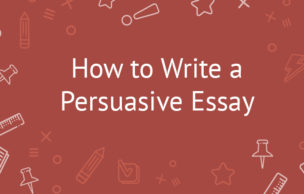How to Create a Persuasive Essay Outline
A persuasive essay is intended to convince your reader that a particular idea is the absolute truth or that a specific point of view is the only one possible to take. Contrary to argumentative essays where you argue a point by presenting as many supporting facts as possible and refuting any evidence that could favor an opposing view, persuasive essays are not exclusively reliant on facts. In truth, facts are not even a mandatory requirement for writing this type of essay. They are helpful, as is everything that aids you in persuading your audience in the validity of your claims. Emotionally-loaded sentences, at least partially based on factual evidence are the best means to this particular aim.
You can write a persuasive essay on any topic about which you feel strongly or have a stand, which is either pro or con a specific issue. If you have a personal stake in the matter, you will be able to argue it more convincingly. There can be no middle ground in persuasive essays, you cannot acknowledge the possible benefits of the opposing view, and your goal is to show that your road is the only conceivable one to take. If in doubt, you can always try watching political campaigns from any previous elections, the politicians are the absolute masters of persuasion. They have perfected the skill of convincing their voters of practically anything. Is everything they claim the absolute truth? Not necessarily. Try taking some pointers from them when planning to write a persuasive essay.
As in any essay type, writing an outline precedes composing the actual essay and allows for your thoughts and ideas to be organized in a structured way. The outline envisions all elements your future essay will have and the way they will be systematized.
Organizational structure of a persuasive essay outline
- Introduction
- It is the part where you “place a bait," or compose a sentence or paragraph which serves as a hook intended to grab your reader's attention. Don't shy away from strong statements even if they feel just a bit too strong. Your objective is for your readers to continue reading and to take your side. Most of the time, it's just as easy to convince someone to be in favor of a particular issue as it is to convince them against it. It's all about being persuasive enough. The hook can be in the form of statement, a question or even exclamation. Everything goes as long as it can make your audience laugh or bring tears to their eyes. Anything short of that will probably not be enough.
- The next element of a compelling introduction is determining your target group. Knowing who will read you can help you formulate your statements to suit your audience’s needs. Specific groups are especially sensitive towards particular issues. For example, you can be almost sure that young mothers would be in favor of constructing a new children's playground or building another day-care center, whereas a middle-aged business executive will not be particularly touched by these issues. Knowing your target group helps you address them most suitably, appealing to their logic, emotions or sense of morality predominantly.
- A thesis statement is the last element of a persuasive essay outline. It conveys the exact message on the matter for which you are trying to get support. Formulate it convincingly, without any hesitation or even a hint of any other possible solution to a problem. For example, "Children have the right to grow up in a safe environment that takes their developmental needs seriously. Building a playground with state of the art equipment to stimulate their cognitive and motor development is an investment in our future as humankind". No one can argue with that, can they?
- Body Paragraphs containing the reasoning for your thesis statement followed by facts or examples. Try to include reasoning that appeals to logic as well as to emotions and morality. This is how you can do it:
- Paragraph No. 1 – Reason No.1: Children's exposure to a stimulating environment is beneficial for their cognitive and motor development
- Factual evidence: Scientific studies have shown that children reared in highly stimulating circumstances have an IQ score higher by 10 points compared to children brought up without enough stimulation.
- Factual evidence: Children who have an opportunity to practice their motor skills are more physically apt as adults than those not exposed to physical practice at a young age.
- Paragraph No. 2 - Reason No. 2: Children are unable to stand up for themselves and communicate their needs and wants, and necessitate adult intervention on their behalf.
- Emotionally-loaded argument: As human beings, we all have a moral obligation to stand up for those unable to do it themselves.
- Emotionally-loaded argument: Children are born helpless and require adult care and nurturing if they are expected to turn into healthy and productive individuals.
- Paragraph No. 3 – Reason No. 3: The society as a whole will benefit from children getting raised in healthy and stimulating circumstances.
- Fact: A society is composed of individuals: investing in individuals, brings prosperity to the whole community.
- Fact: Children whose time is structured by meaningful physical and mental activity are less prone to behavioral problems, which is beneficial for the society as well.
- Paragraph No. 1 – Reason No.1: Children's exposure to a stimulating environment is beneficial for their cognitive and motor development
All reasons drafted in the outline of the body paragraphs should have one or more of the following features: indisputable logic, strong moral grounds, and/or potential to elicit an emotional reaction. They can be either backed up by scientific or other evidence, ethical considerations or emotionally charged arguments. Be careful to include only one reason in a paragraph. Presenting multiple reasons simultaneously could confuse the readers and make them uncertain of the message you're trying to get across. So take note: one reason per paragraph is the standard.
- Conclusion
- Recapitulation of the main arguments given in the previous part of the outline. This serves as a reminder of the significance of the issue in question. Also, by briefly reiterating the essence of what you had previously said, you reinforce your arguments and make them sound more convincing. That's what a persuasive essay is all about – persuading the audience of the veracity of a particular claim. For example: "In modern society, children are increasingly brought up in front of television sets or computers. The lack of physical exercise is starting to take a toll on the new generation's psychomotor development. Scientists have warned us about this phenomenon for years. Are we going to stand by peacefully while our children suffer?”
- Stating the potential advantages the whole society, including the reader, could have from taking a stand in favor of the issue presented in a persuasive essay. For example: “Being able to rear your children in a stimulating and confidence boosting environment will benefit you as a parent too as you will be able to see your child live up to his/her full potential. By signing the petition to build new playgrounds, you will be certain that you did everything in your power to allow your kids to have the best possible conditions for healthy development.”
- Call for action – explaining what you would like your readers to do if you had succeeded in persuading them in your point of view. For example: “Sign a petition to construct the new playground with modern equipment! It’s our duty as parents to speak up on behalf of our children! They rely on us to do so.”
The conclusion serves the purpose of solidifying your argument and making an impression on your readers. You should write it in a way that makes it extremely hard to say no to. Rejecting your initiative should be guilt-provoking, therefore making members of your audience prone to accept it just to feel good about themselves. As mentioned before, persuasive essays are not just about facts and evidence. They are emotionally loaded and based on sound ethical grounds. This often proves decisive in tipping the scale in the desired direction.
The goal of an outline for writing a persuasive essay is to organize your thoughts and feelings on the subject, to think of the best ways to address your audience, and to determine which arguments you could use with most effect. To be successful, you will not just pile up ideas and overwhelm your readers with unorganized material that is hard to follow. If you want them to support your claims or initiatives, these need to be presented in a structured and logical way, which is precisely what an outline is for.





